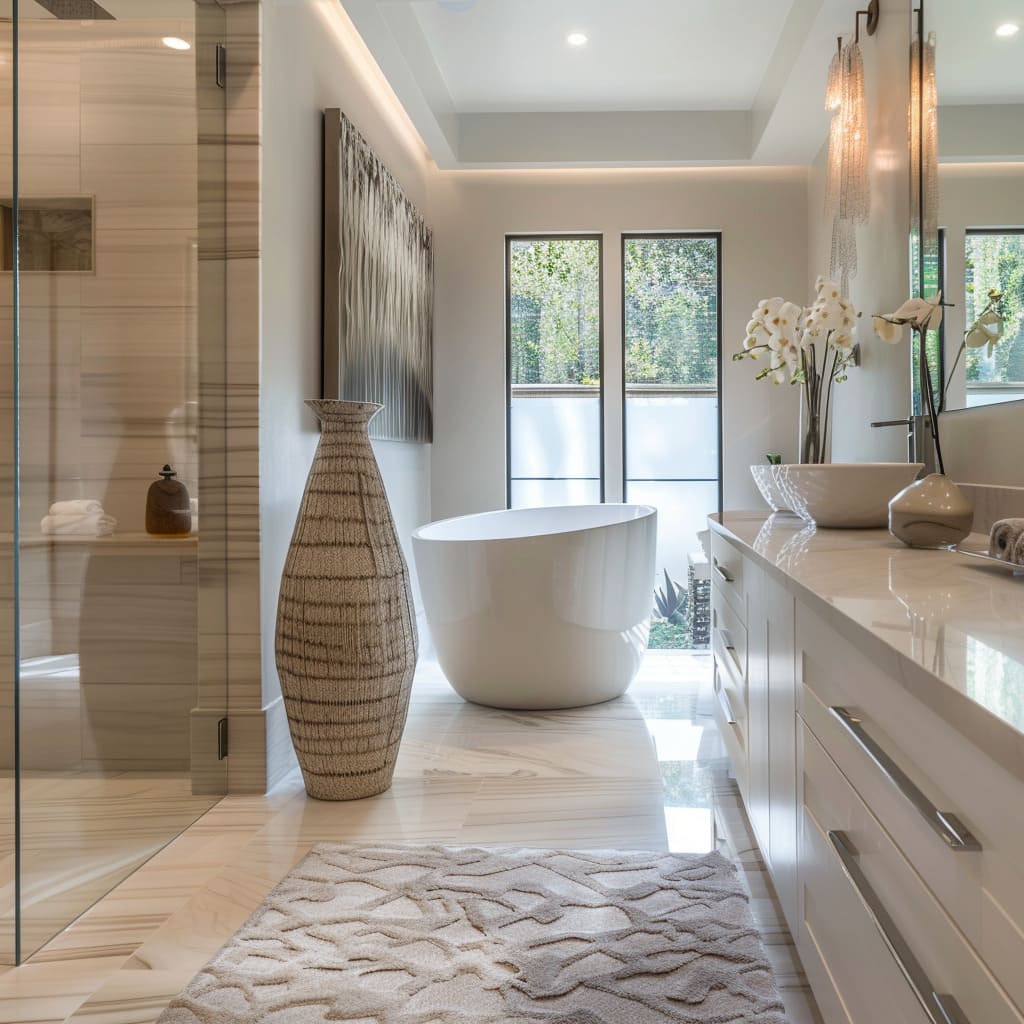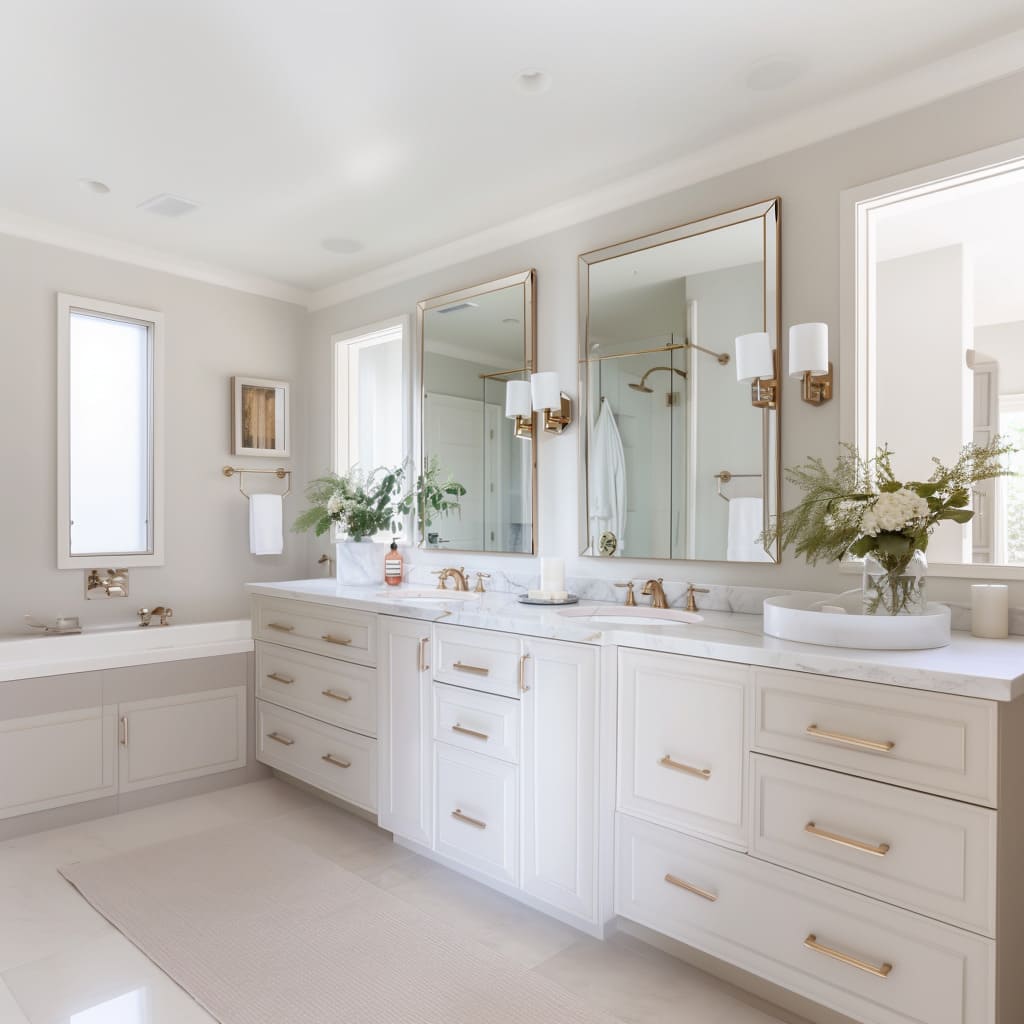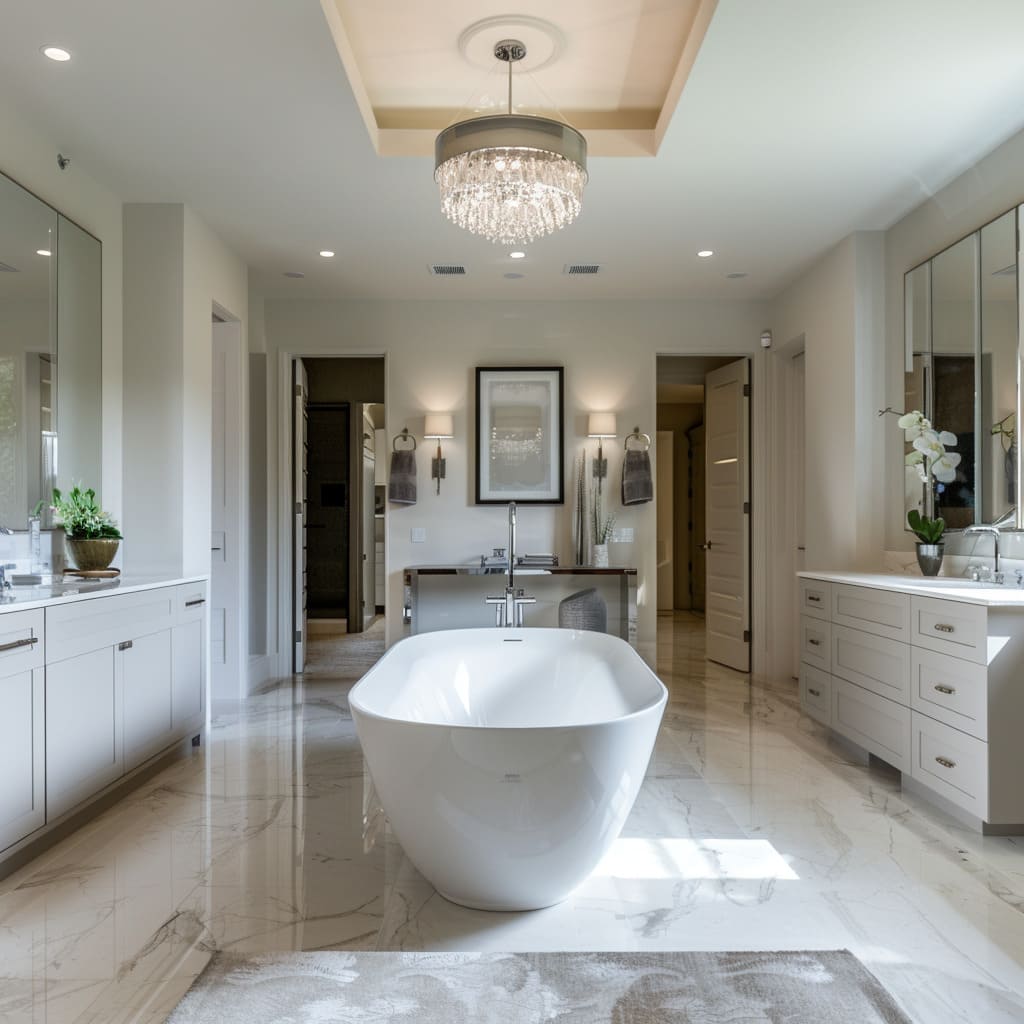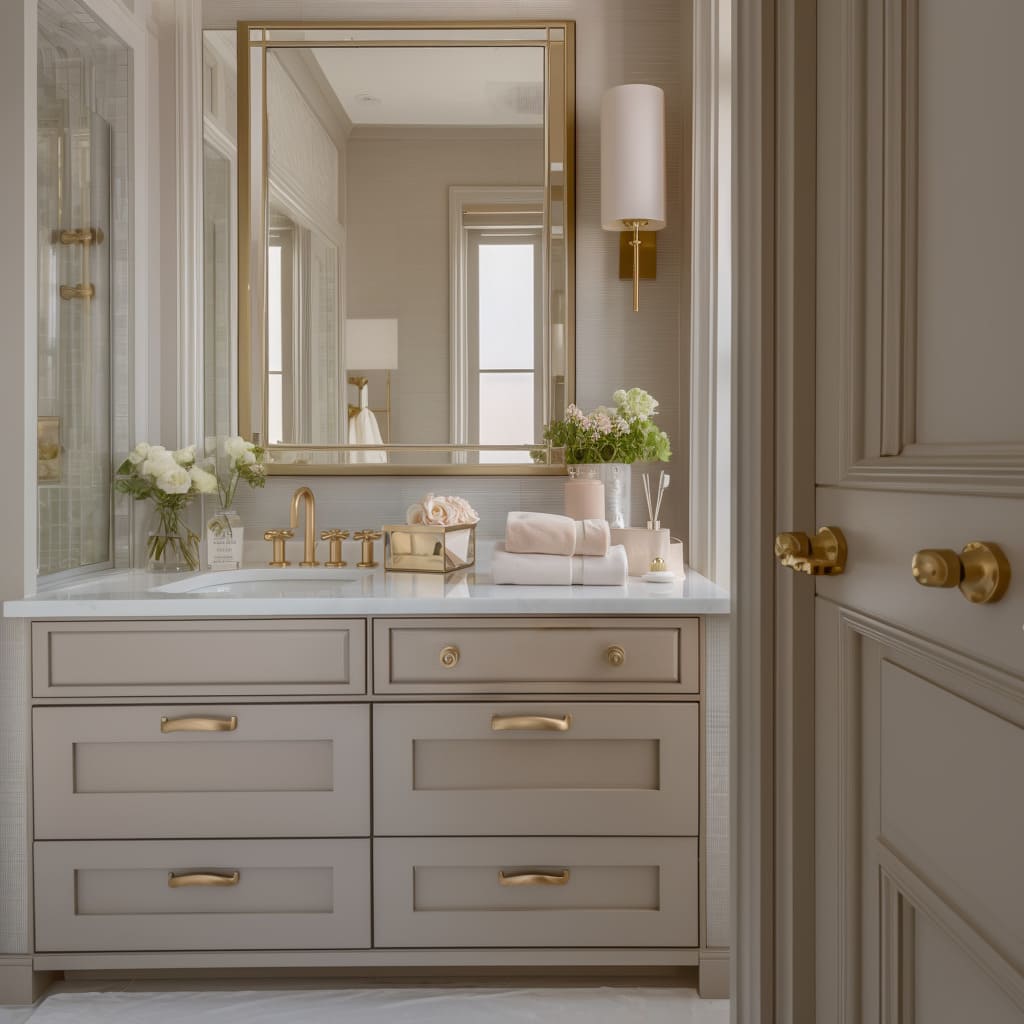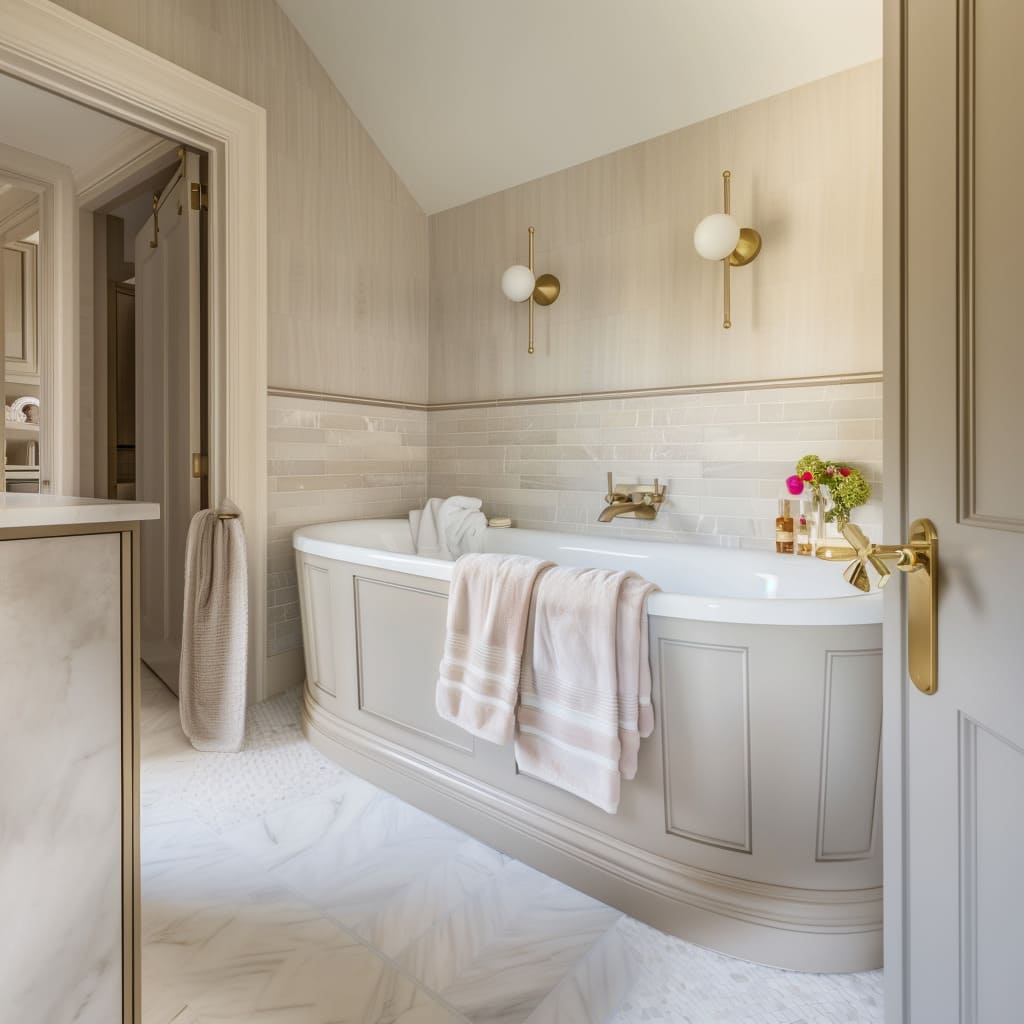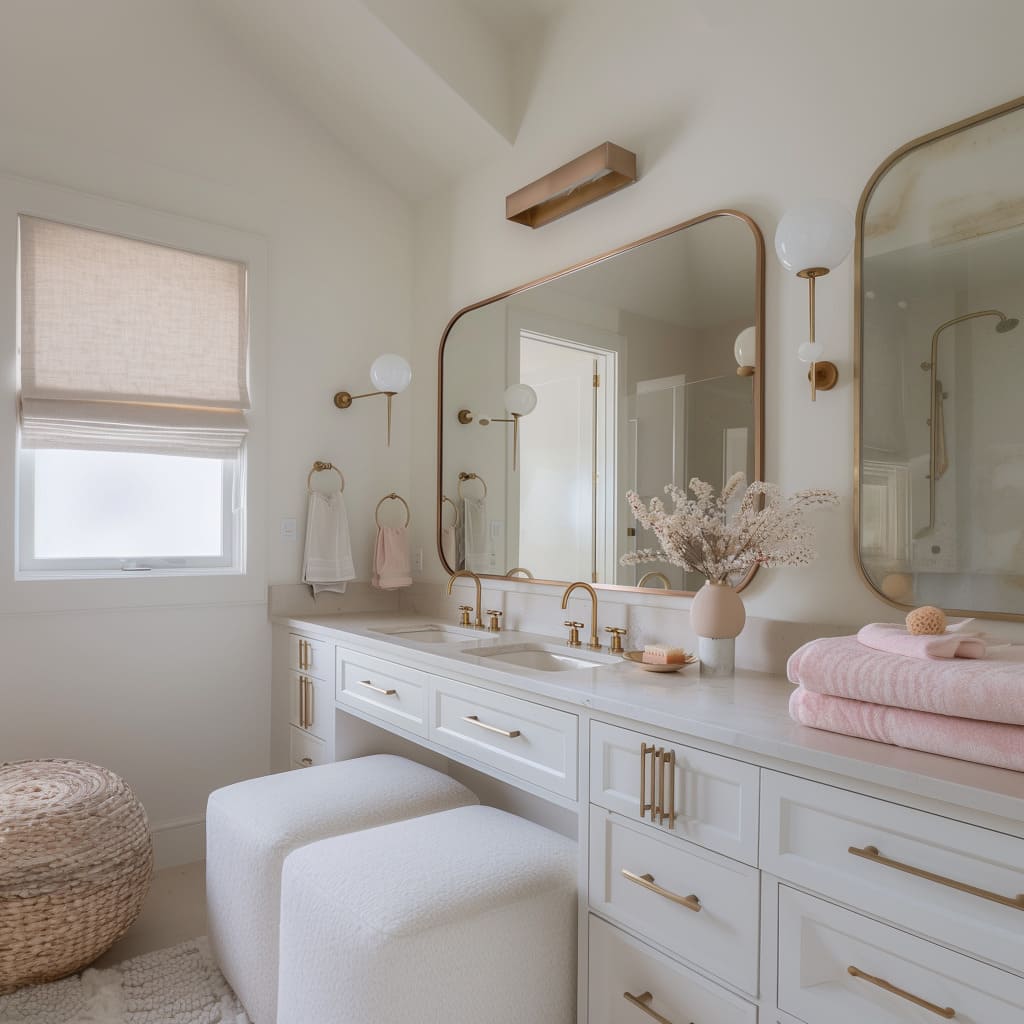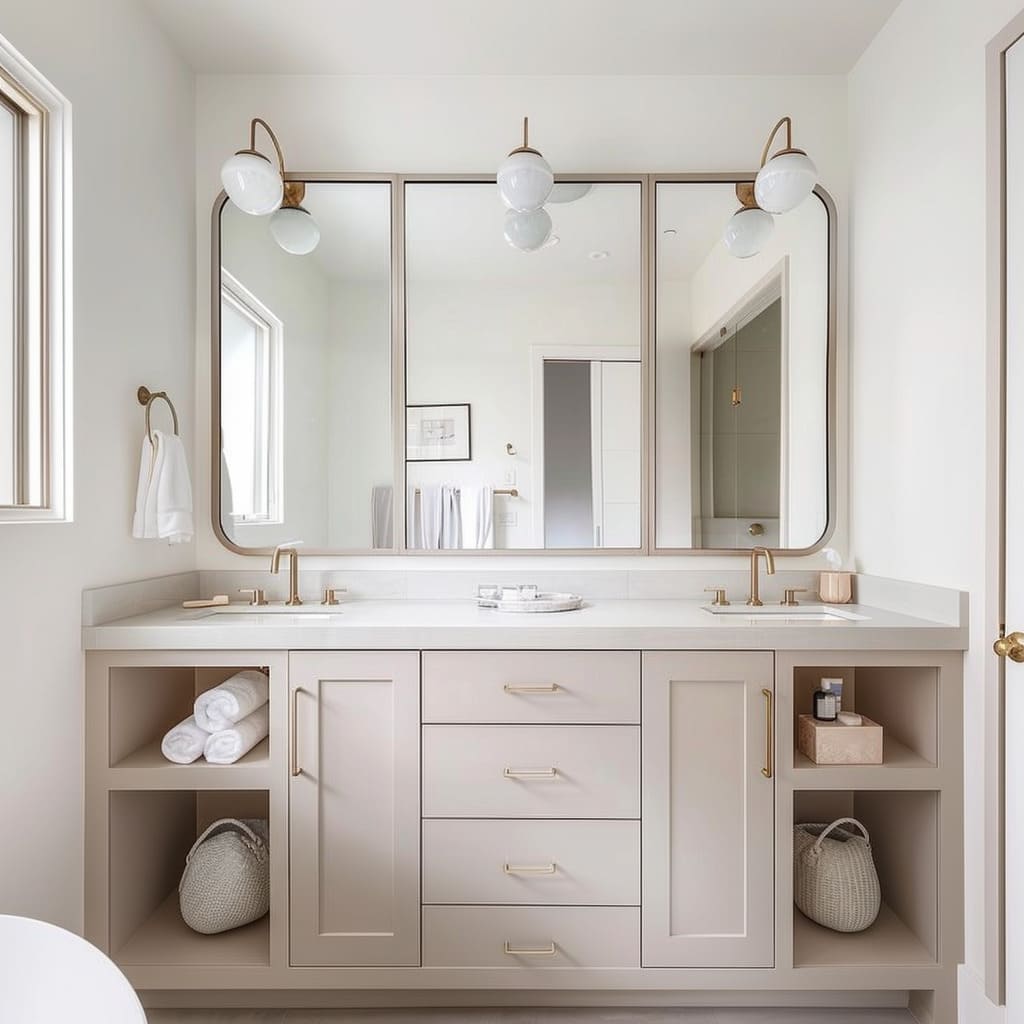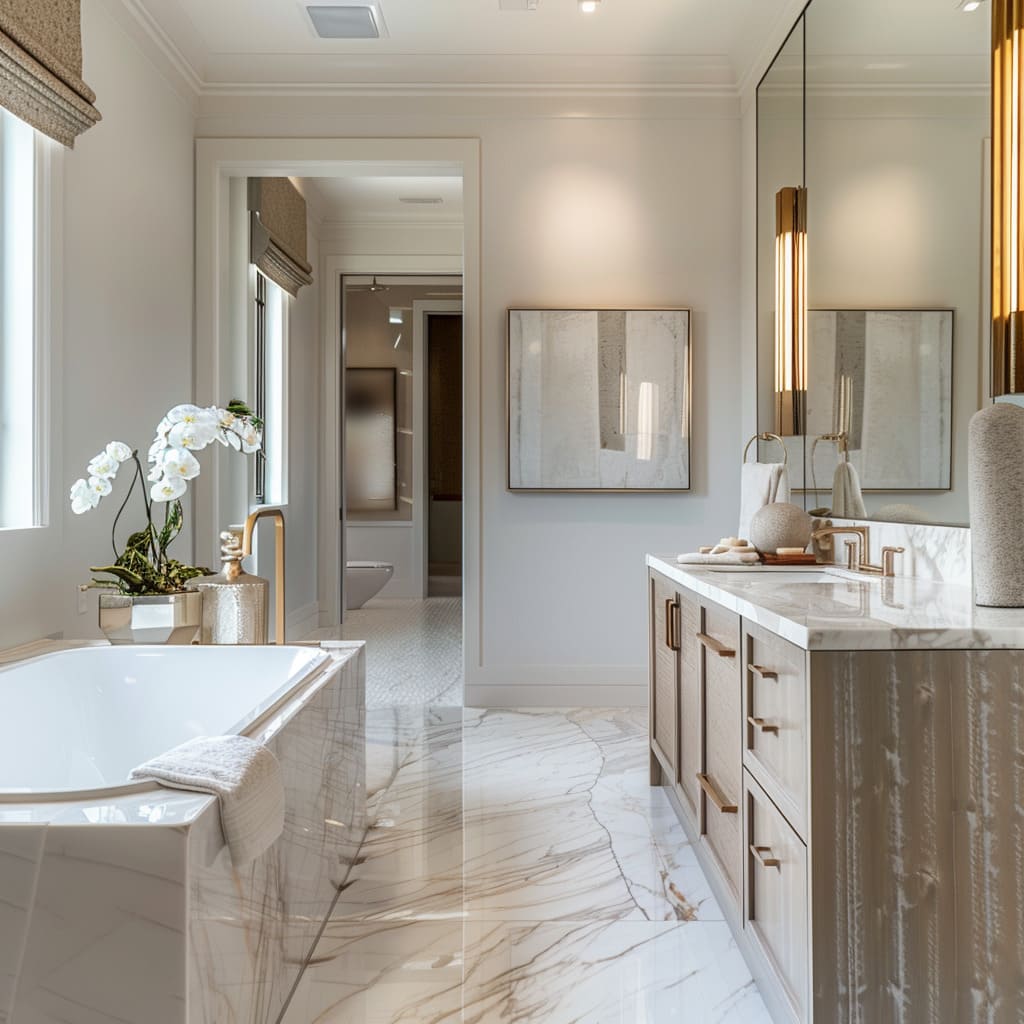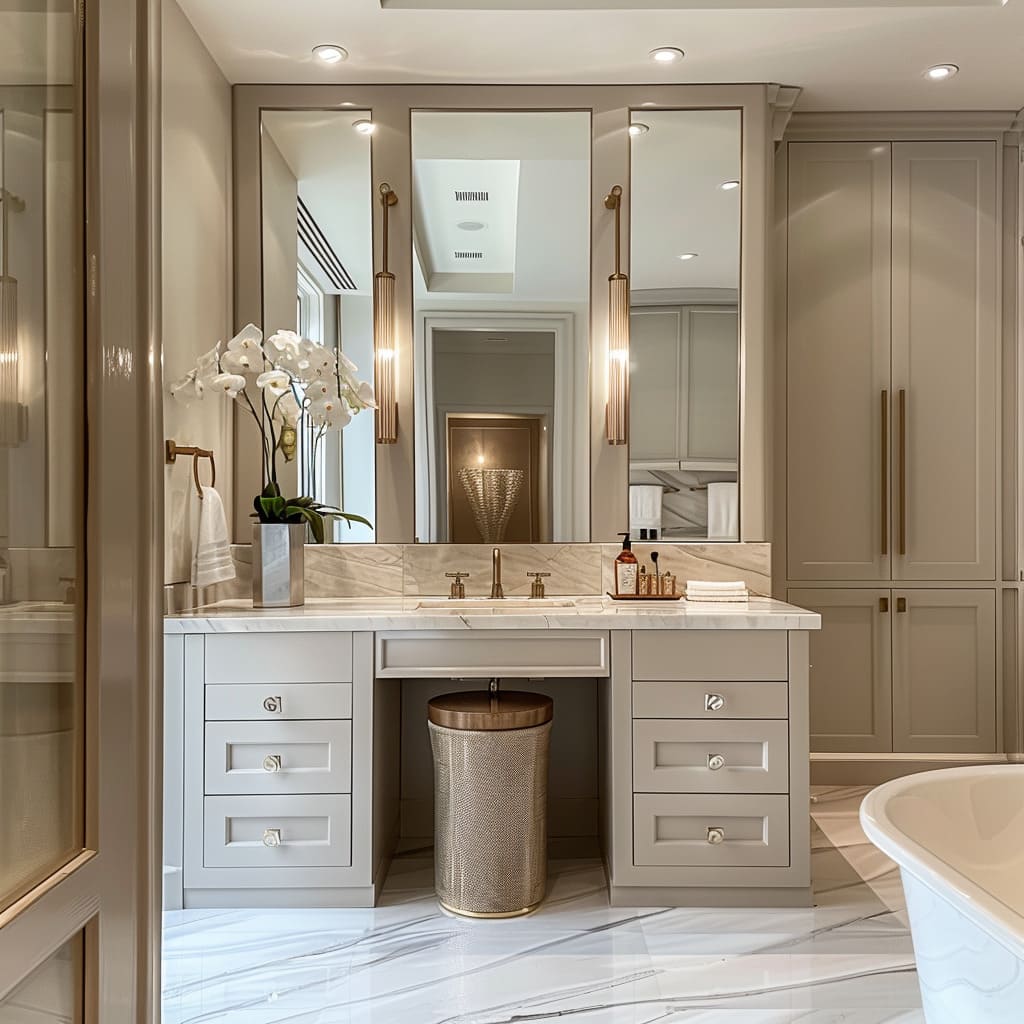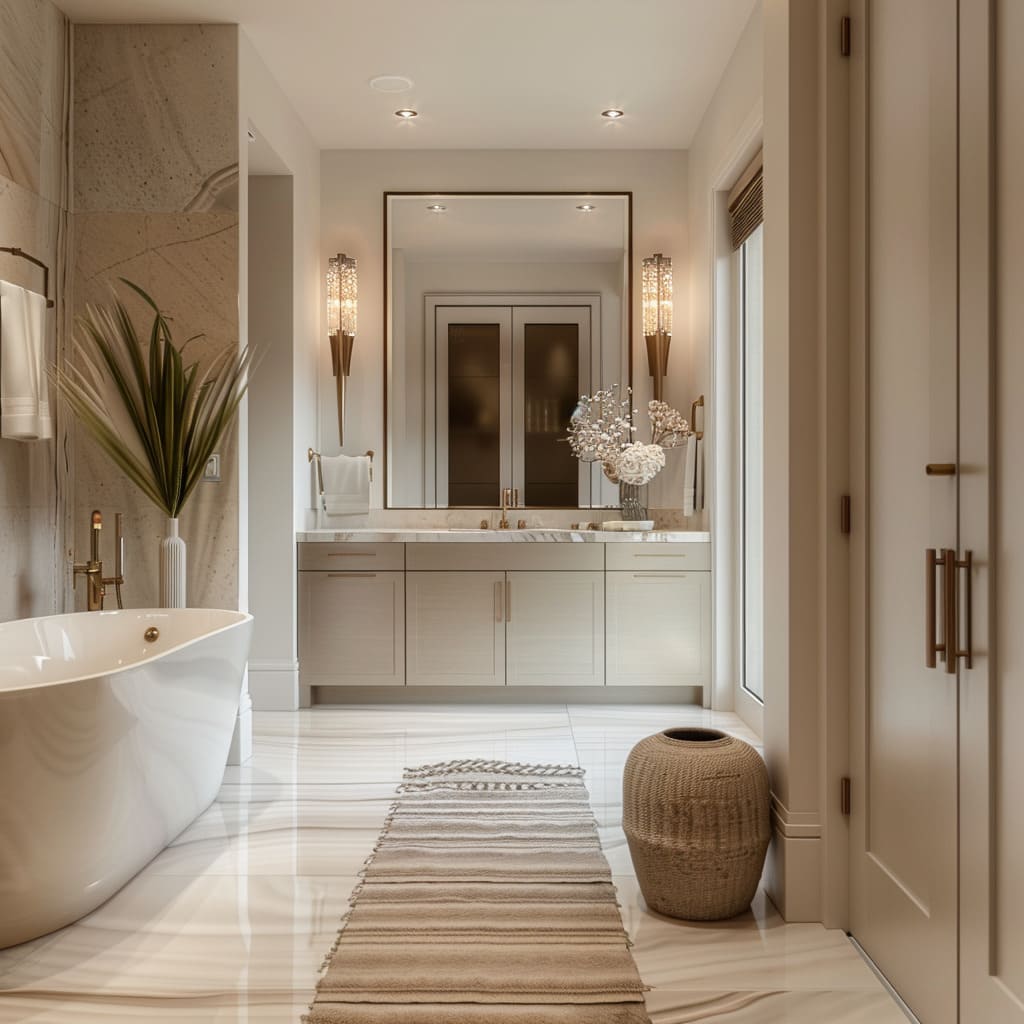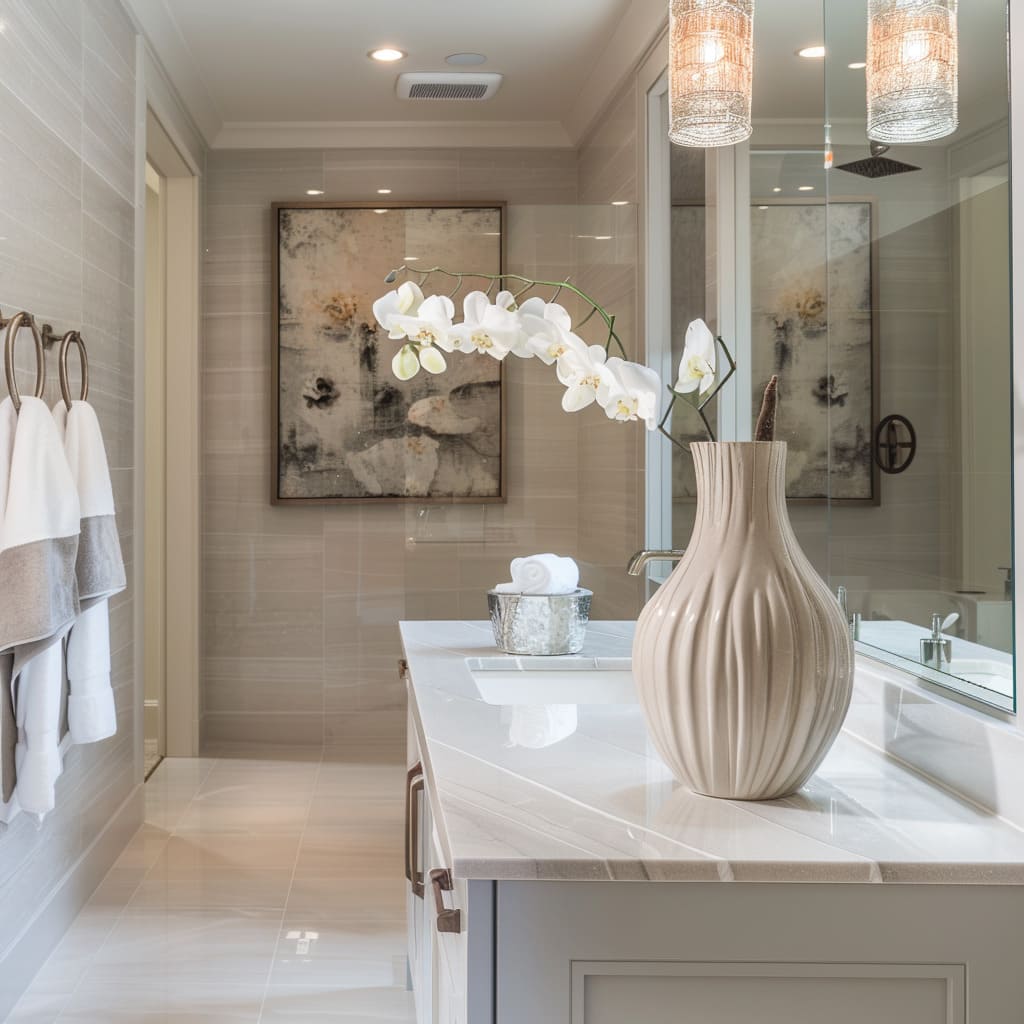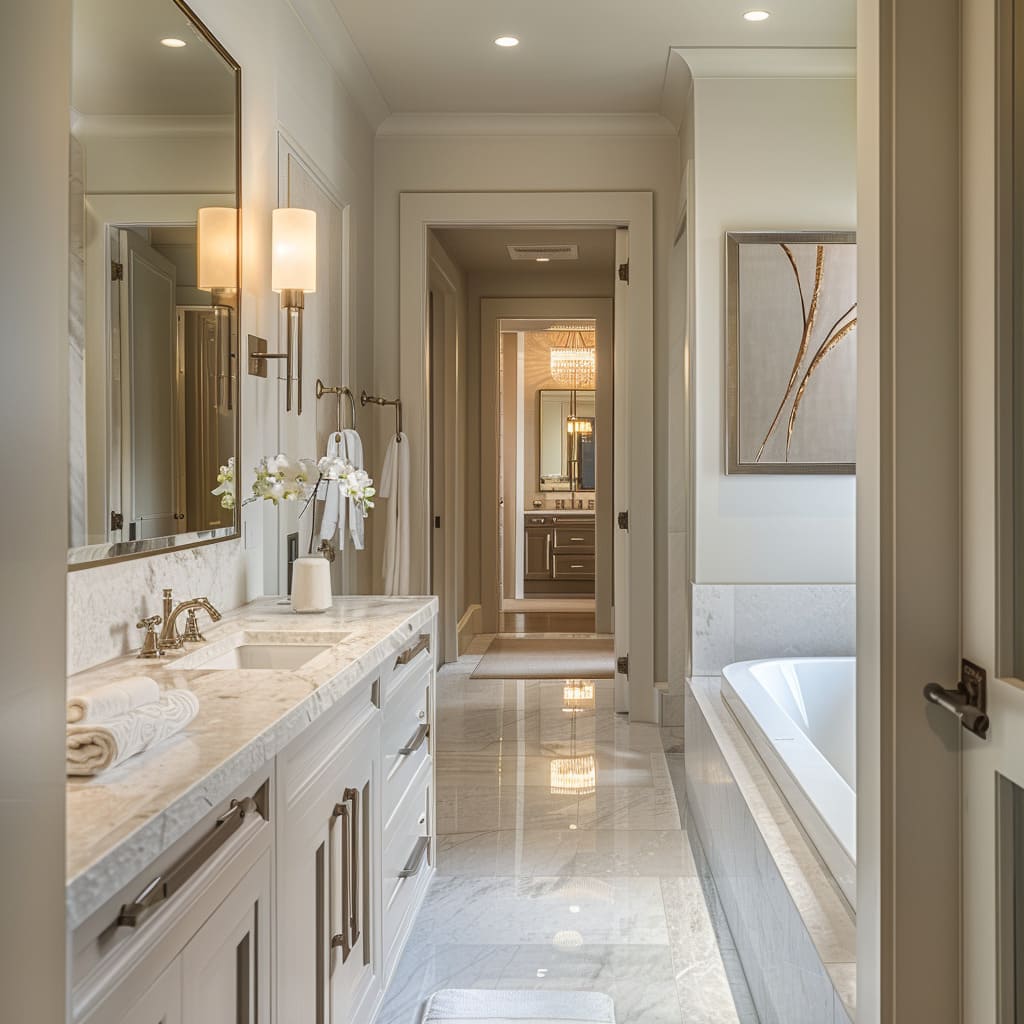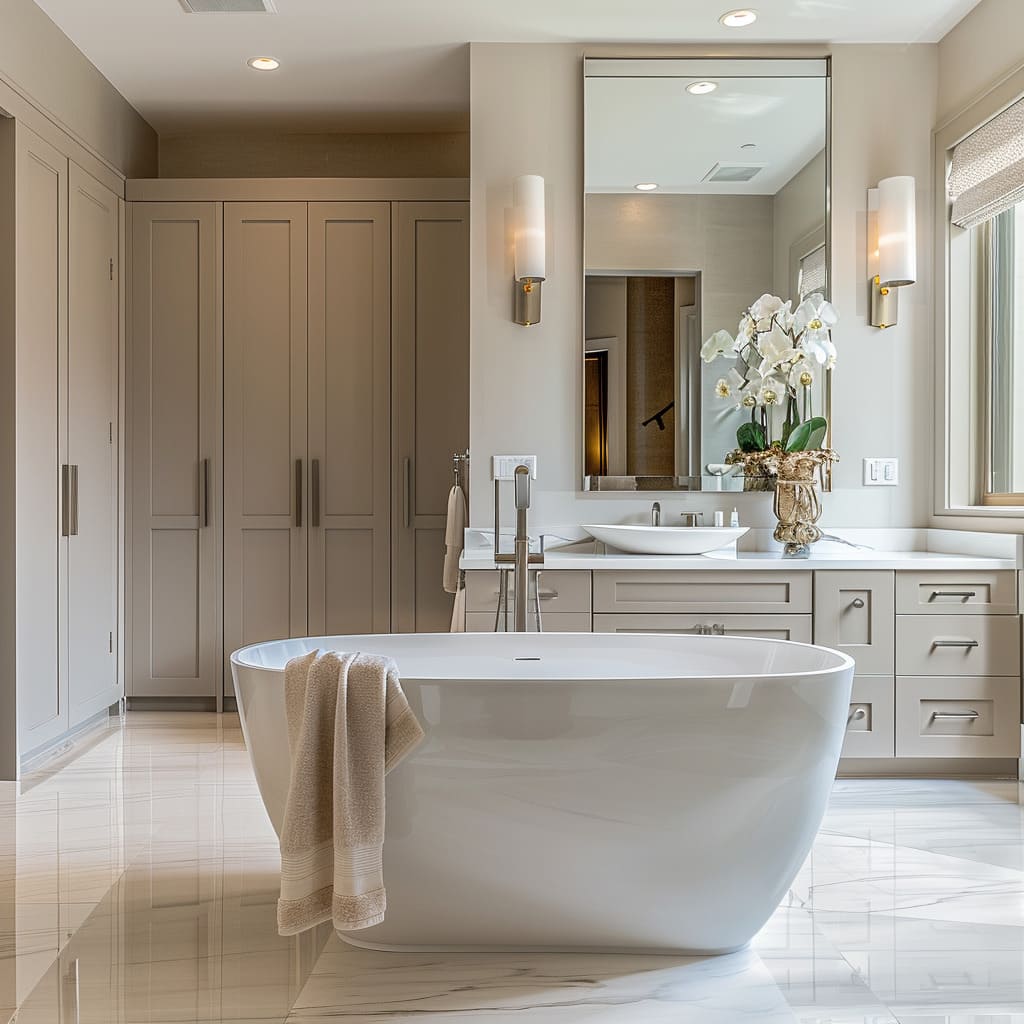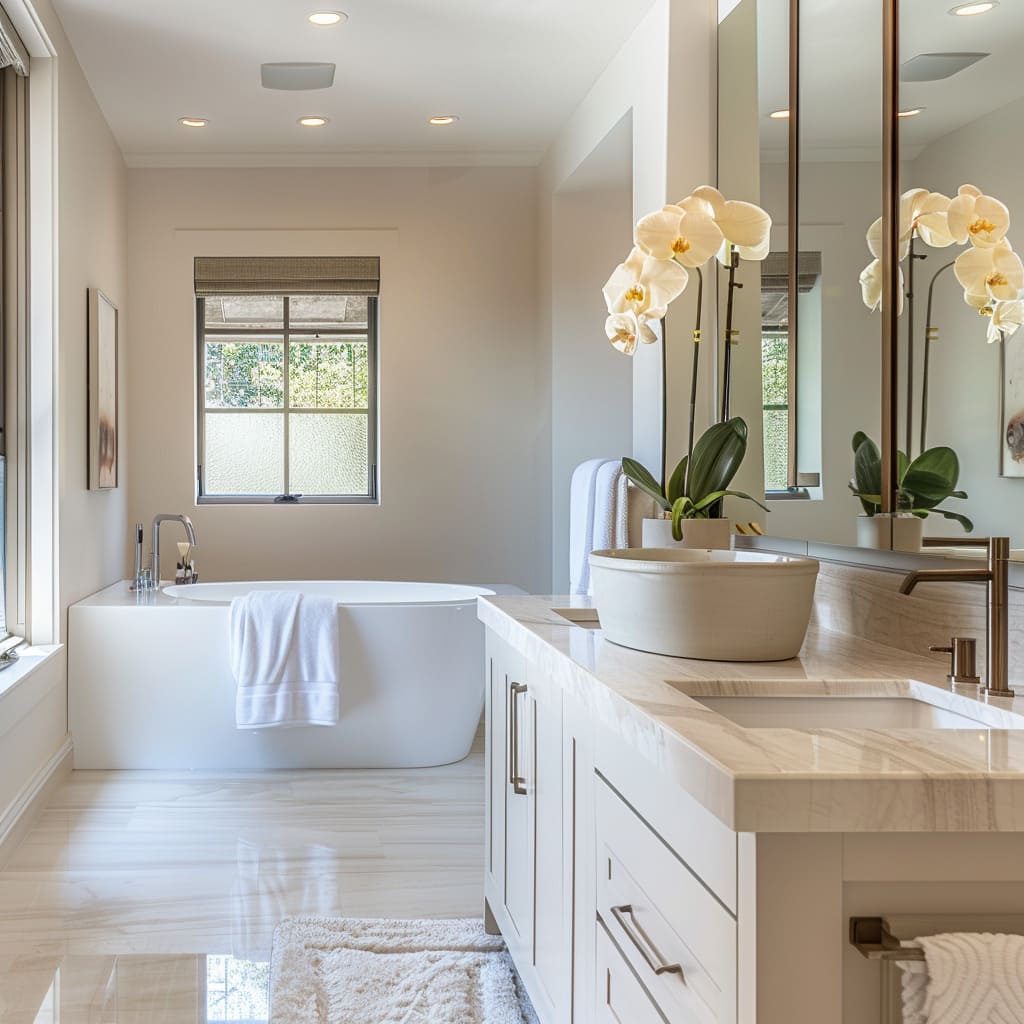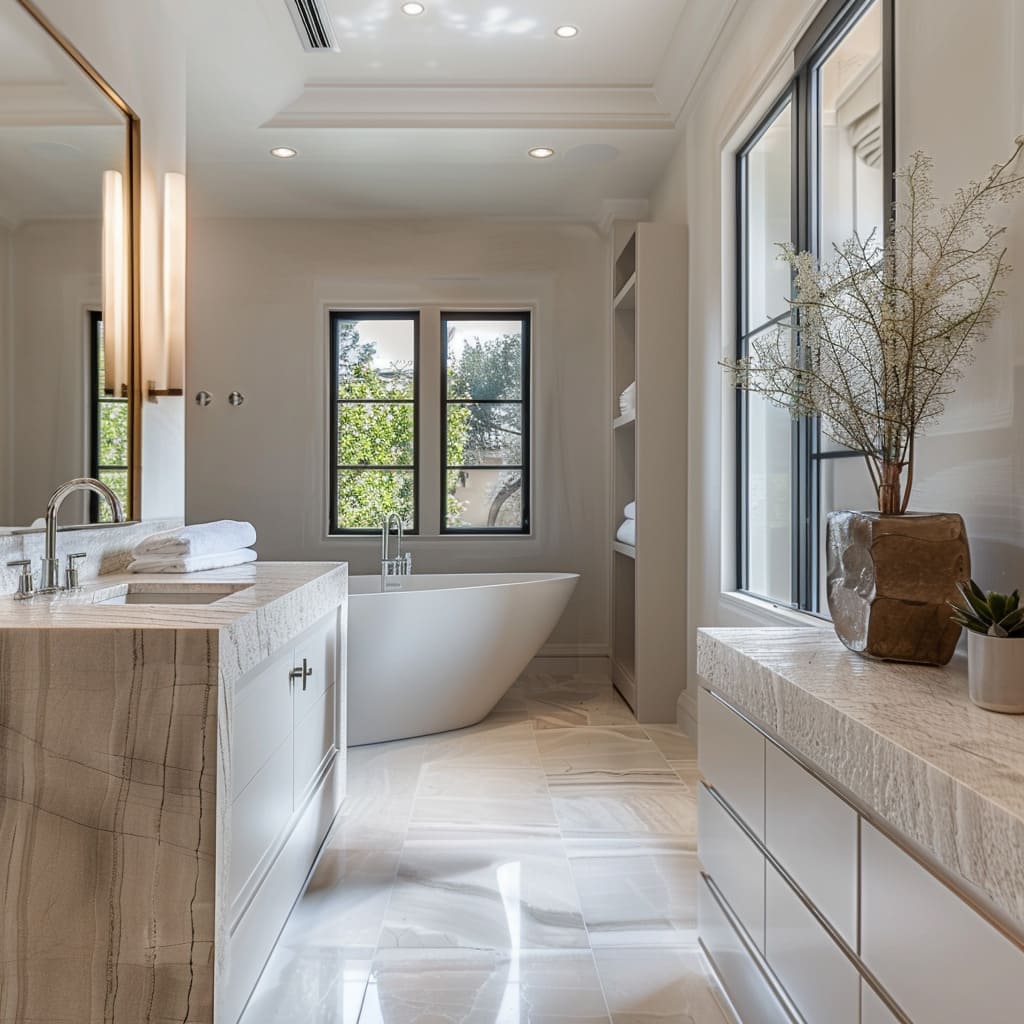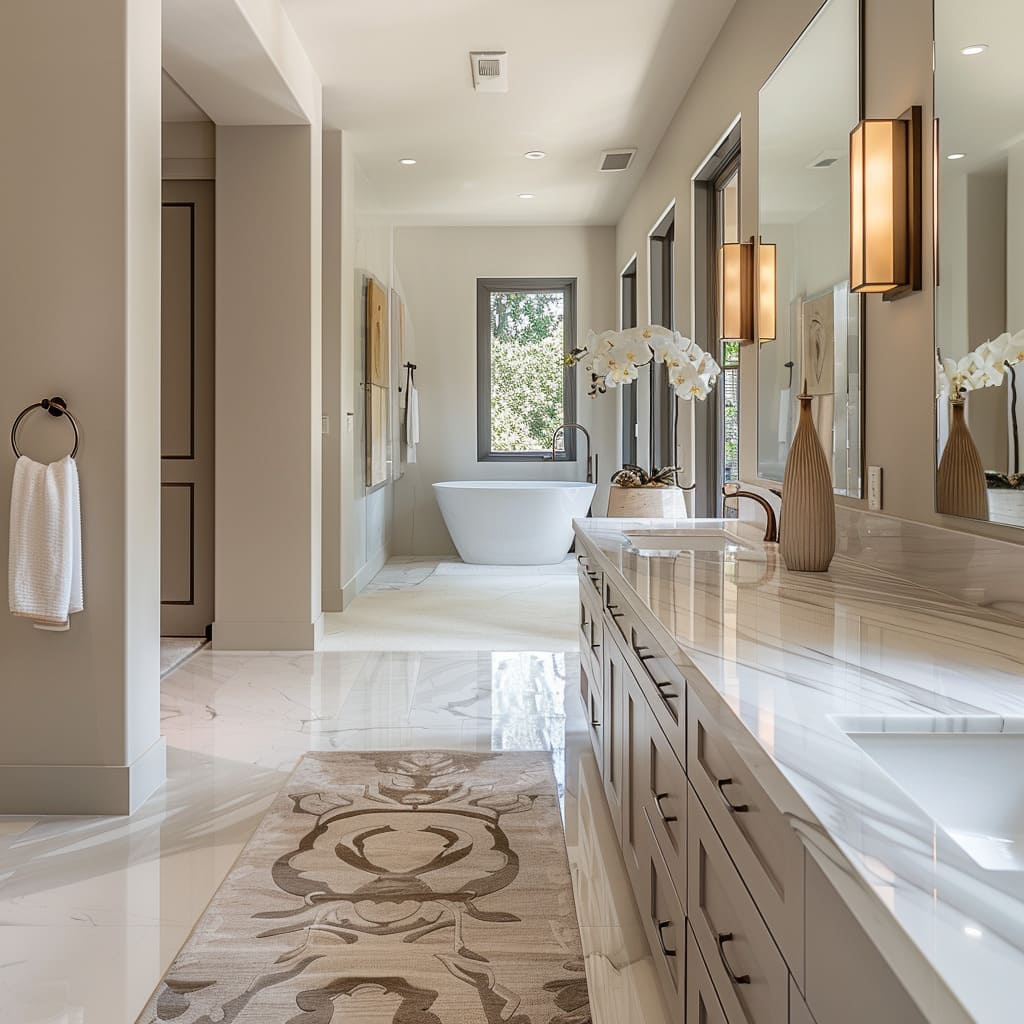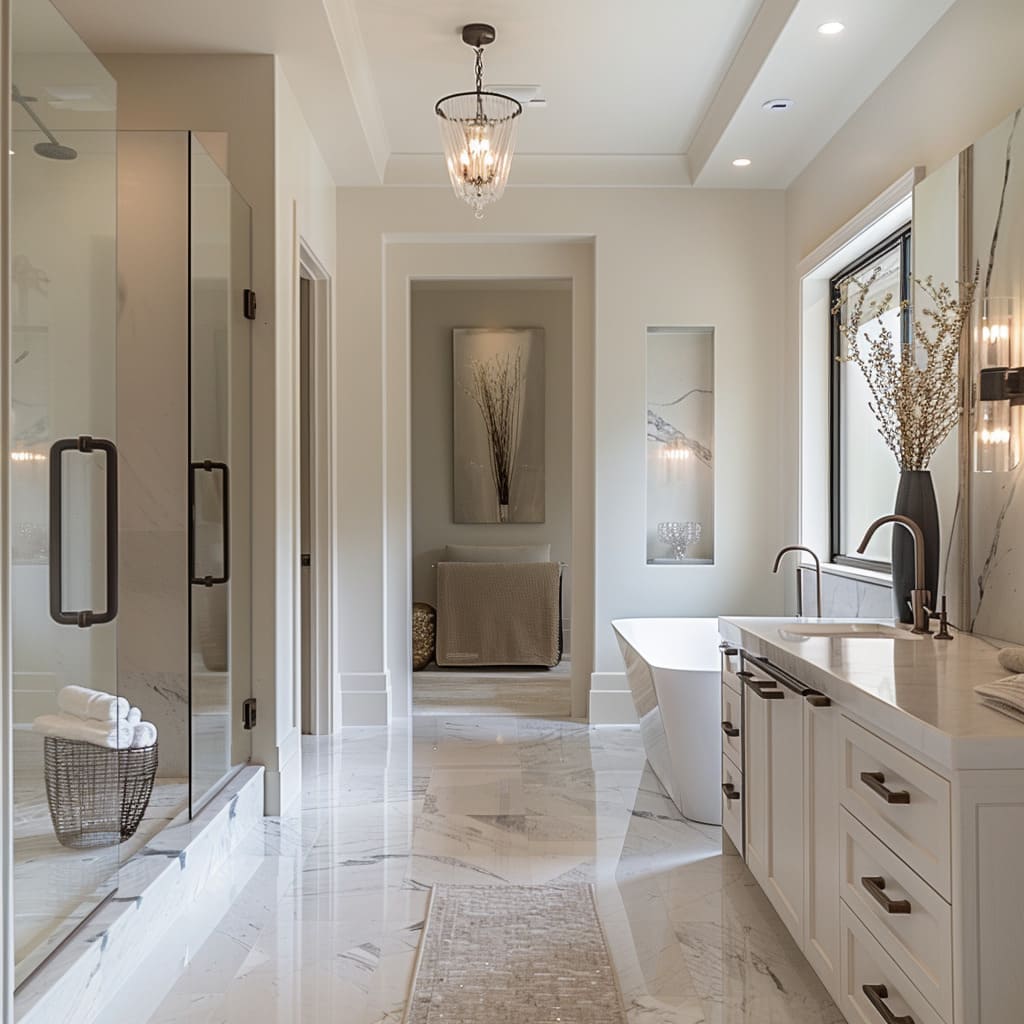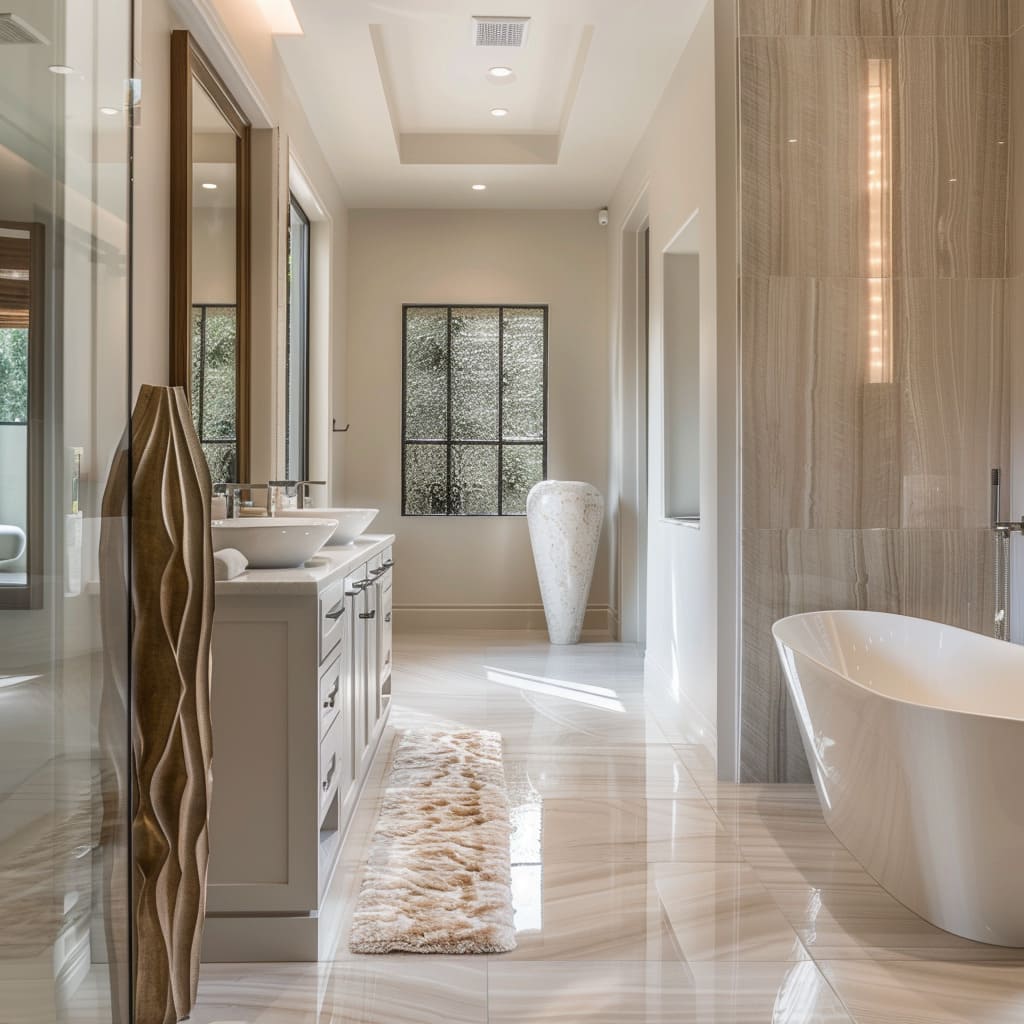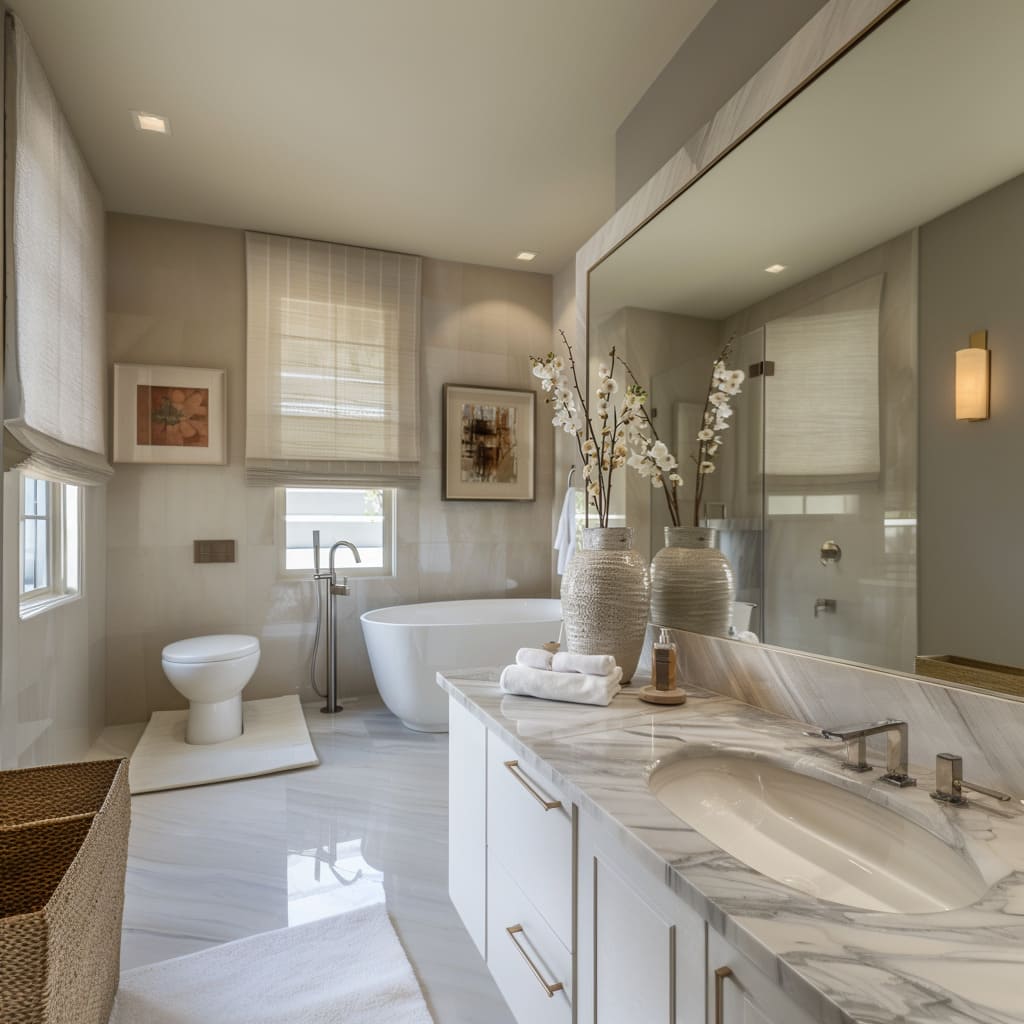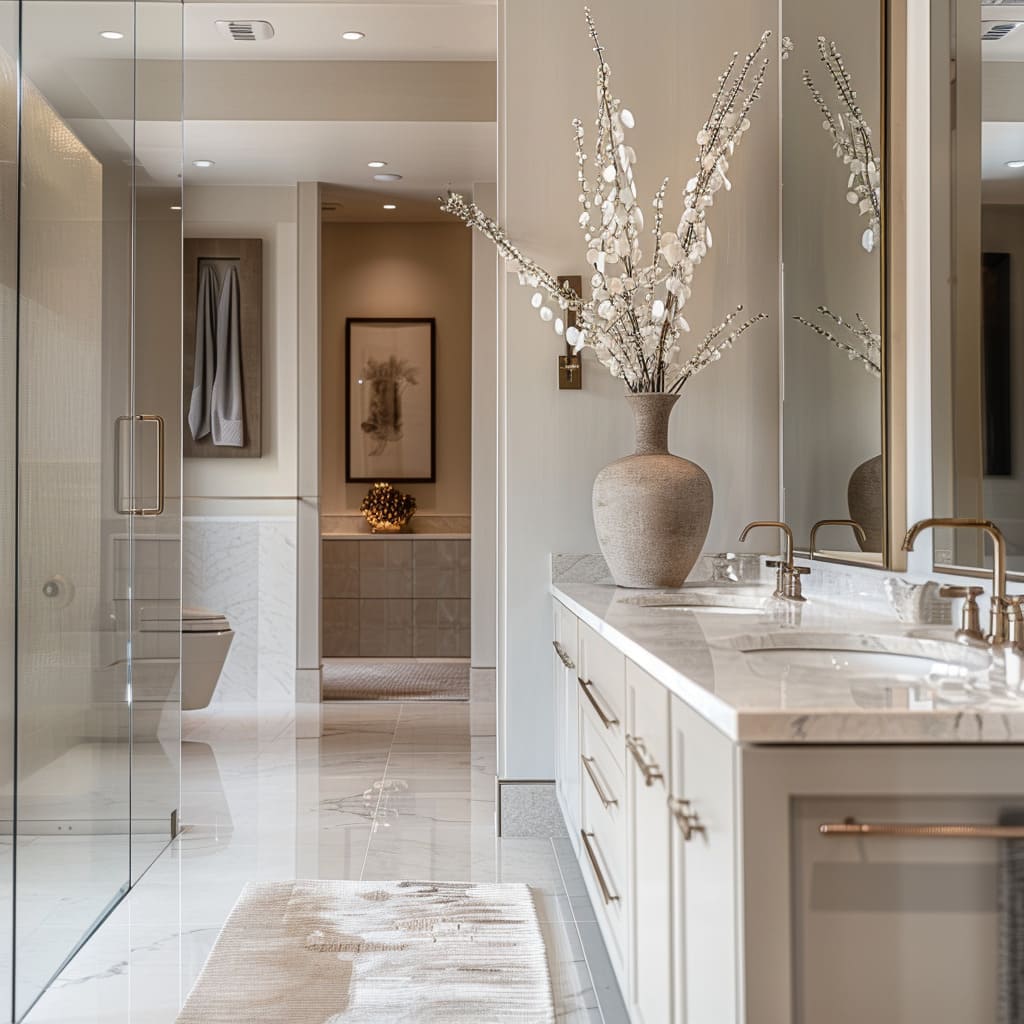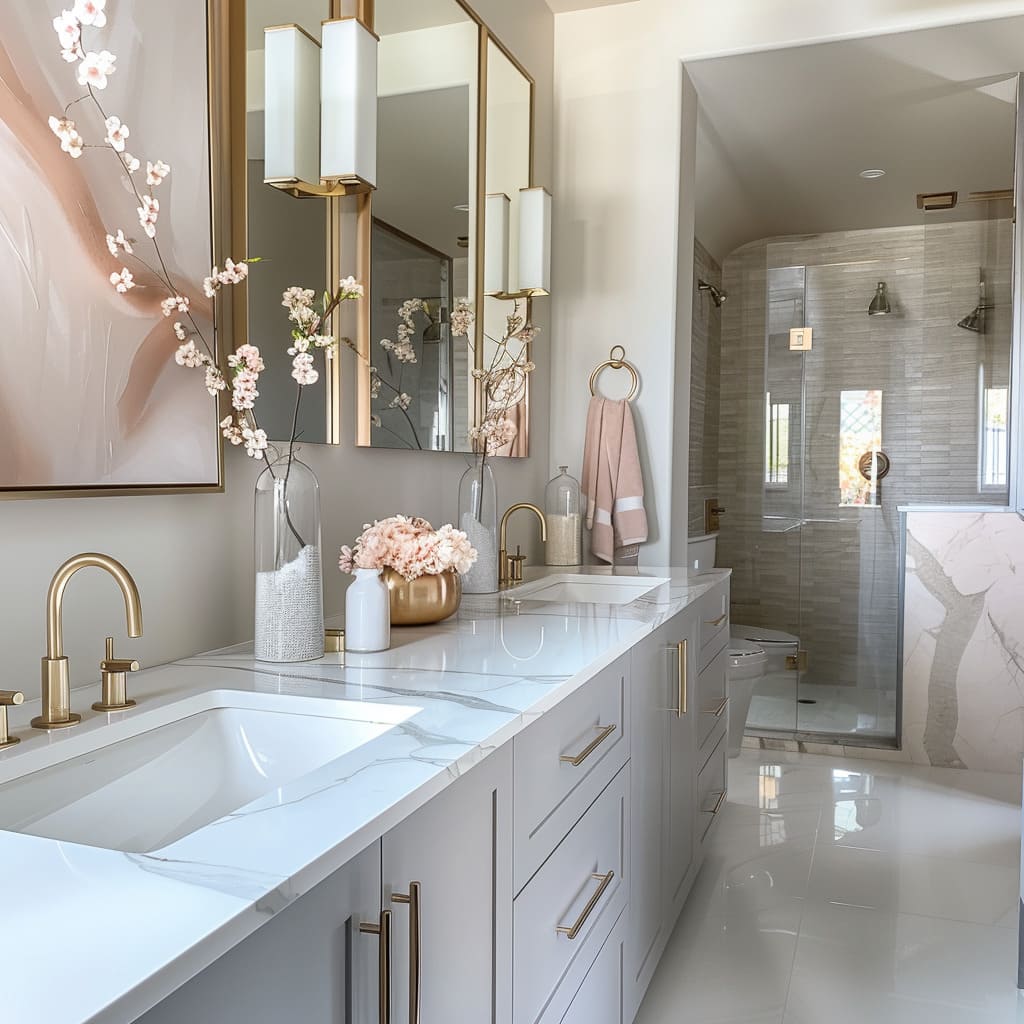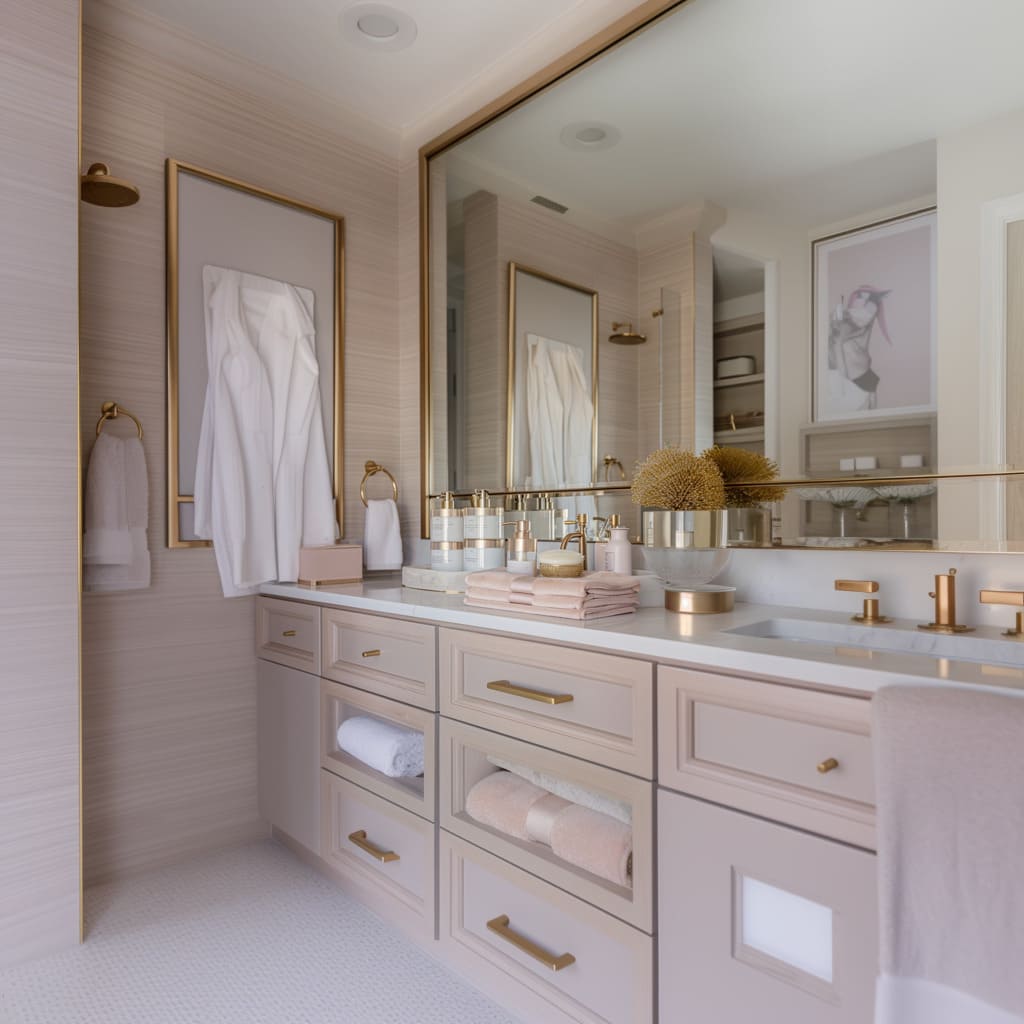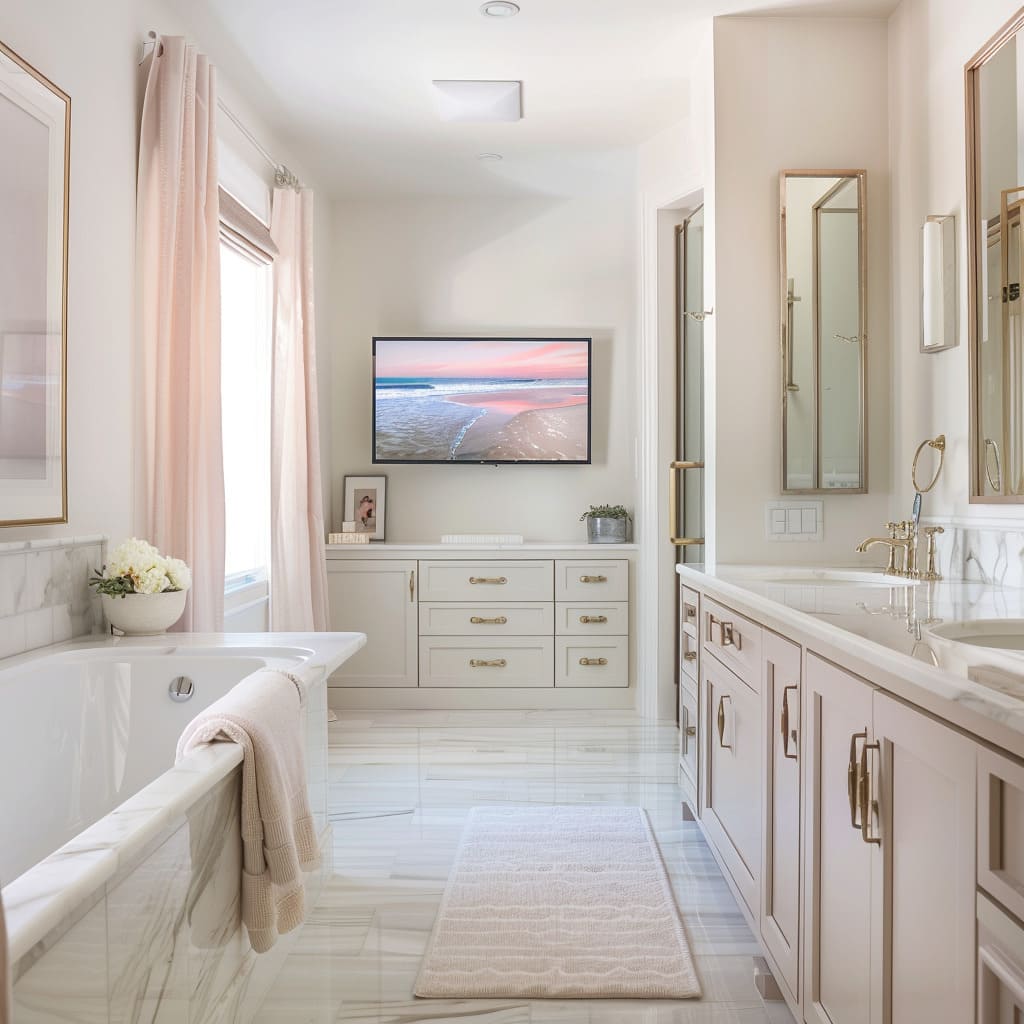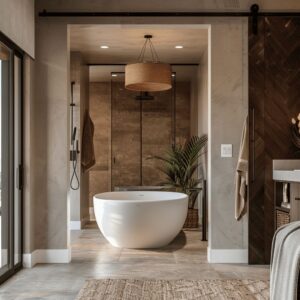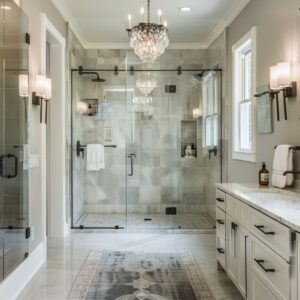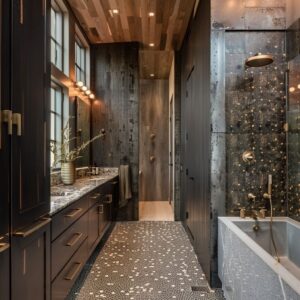When it comes to designing a master bathroom, the choice of color can set the tone for the entire space. Opting for off-white hues offers a sophisticated and timeless look, creating a setting that feels both welcoming and refined.
These shades are known for their ability to reflect light and enhance the sense of space, making them a popular choice in modern bathroom design. With a palette that is both versatile and enduring, off-white tones can transform a bathroom into a sanctuary of calm and understated luxury.
This article delves into the key design elements that can help you achieve a luxurious master bathroom using off-white hues. From the selection of materials to the integration of thoughtful features, we will explore how to create a space that balances both function and style.
Drawing on detailed examples, the following sections will guide you through the benefits and considerations of using off-white tones in your master bathroom design
The Appeal of Off-White Hues in Master Bathroom Design
Creating a Calm Atmosphere
Off-white hues are often associated with calm and relaxation. In a master bathroom, these tones help to create a space where you can unwind and feel at ease.
The softness of off-white tones avoids the starkness of pure white while maintaining a sense of cleanliness and order. By using these shades on walls, cabinetry, and even in your choice of towels and accessories, the bathroom becomes a peaceful retreat within your home.
These colors work especially well in combination with natural light, wood accents, and plush textures, all of which contribute to a space that feels inviting and restful
Enhancing Natural Light
One of the standout qualities of off-white hues is their ability to reflect natural light. This quality makes a bathroom feel more spacious and airy, a crucial consideration in spaces that may lack abundant square footage.
When sunlight streams through windows, it bounces off the light surfaces, illuminating the room and creating a bright, fresh atmosphere. This effect is particularly beneficial in master bathrooms, where a bright and open feel can make the room more enjoyable and functional.
The reflective nature of off-white tones also pairs well with mirrors and other glossy surfaces, further amplifying the light and enhancing the overall brightness of the space
Versatility and Timelessness
Off-white hues offer a unique versatility that allows them to blend seamlessly with a variety of design styles. Whether your bathroom leans toward modern minimalism, classic elegance, or even a more rustic aesthetic, off-white serves as a perfect backdrop.
This color palette is not only versatile but also timeless, ensuring that your bathroom remains stylish for years to come. Off-white tones can be paired with bold accent colors, natural materials, or metallic finishes to create a personalized and cohesive design.
Their understated nature means that they never go out of style, making them a smart choice for homeowners who want to invest in a bathroom design that will stand the test of time
Key Elements of Luxurious Master Bathrooms
Freestanding Bathtubs
Design and Placement: A freestanding bathtub often serves as the centerpiece of a luxurious master bathroom. Its sleek, curved lines add a sculptural element to the space, drawing the eye and creating a focal point that embodies relaxation.
Positioned thoughtfully near large windows, the bathtub becomes more than just a functional item; it offers a place of retreat where one can soak while enjoying the natural light and views. The placement of the tub near windows also enhances the overall ambiance, allowing for a bathing experience that feels both private and connected to the outdoors.
This strategic location not only maximizes natural light but also gives the bathroom an open, airy feel, making the space seem larger and more inviting
Material Choices: The material of the bathtub plays a crucial role in both its aesthetic appeal and the overall harmony of the bathroom. Common choices for freestanding tubs include acrylic, stone resin, and cast iron, each bringing a different texture and finish that can complement the off-white color scheme.
Acrylic tubs, with their smooth and glossy finish, align well with a modern bathroom design, offering durability and ease of maintenance. Stone resin tubs, on the other hand, provide a matte finish with a more natural, tactile feel, adding an organic element that blends beautifully with neutral tones.
Cast iron tubs, often finished with a high-gloss enamel, add a touch of classic elegance, pairing well with metallic fixtures to create a sophisticated contrast within the bathroom’s palette
Expansive Vanities with Off-White Cabinetry
Design and Layout: A well-designed vanity is a cornerstone of any master bathroom, offering both style and functionality. Expansive vanities with off-white cabinetry create a seamless integration with the overall bathroom design, enhancing the room’s sense of continuity.
The layout of the vanity is typically long and spacious, providing ample counter space and storage options. The off-white finish of the cabinetry allows the vanity to blend effortlessly with the rest of the bathroom, maintaining a cohesive aesthetic.
The clean lines of the cabinetry, paired with simple hardware, ensure that the vanity remains timeless while offering a luxurious, yet understated presence in the room
Countertop Materials: The choice of countertop material is essential in achieving a luxurious feel in the bathroom. Light-colored materials such as quartz and marble are popular options, known for their durability and refined appearance.
Quartz countertops, available in a variety of subtle patterns and tones, offer a non-porous surface that is resistant to stains and scratches, making it a practical yet sophisticated choice. Marble, with its natural veining and unique patterns, adds a touch of opulence to the bathroom, creating a focal point that contrasts gently with the off-white cabinetry.
Both materials contribute to the luxurious ambiance of the space, reflecting light and enhancing the bathroom’s overall aesthetic
Storage Solutions: An expansive vanity with ample storage is key to maintaining a clean, uncluttered look in a master bathroom. Integrated storage solutions such as deep drawers, built-in organizers, and concealed shelves allow for easy access to essentials while keeping the counter space clear.
The use of pull-out shelves and soft-close drawers enhances the functionality of the vanity, ensuring that everything has its place without disrupting the visual flow of the design. Off-white cabinetry helps to maintain a bright and airy feel, even with the storage spaces fully utilized, ensuring that the bathroom remains both functional and stylish
Elegant Mirrors and Lighting Fixtures
Mirror Design: Mirrors in a master bathroom are more than just practical; they also play a significant role in enhancing the room’s sense of space and light. Large, frameless mirrors are a popular choice, as they offer a sleek and unobtrusive design that complements the bathroom’s clean lines.
These mirrors reflect light throughout the room, amplifying the brightness and making the space feel more expansive. Positioned above the vanity, they create a sense of symmetry and balance, contributing to the bathroom’s overall aesthetic.
The use of multiple mirrors, either side-by-side or across different walls, can further enhance the room’s visual impact, making it feel even more luxurious
Lighting Options: Lighting is a critical element in the design of a master bathroom, affecting both its functionality and ambiance. Wall sconces, often placed on either side of the vanity mirror, provide focused light for daily grooming tasks while adding an elegant touch to the space.
Chandeliers or pendant lights above the bathtub or in the center of the room can introduce a statement element, drawing attention and adding a layer of sophistication. Recessed lighting, used strategically throughout the bathroom, ensures that the space is evenly lit without overwhelming the senses.
The combination of different lighting sources creates a balanced and inviting atmosphere, enhancing the bathroom’s luxurious feel
Shower Area
Enclosure Design: The design of the shower enclosure is pivotal in maintaining the bathroom’s open and airy aesthetic. Glass shower enclosures are a popular choice, offering a clear, unobstructed view of the shower area that makes the room feel larger and more cohesive.
These enclosures often feature frameless designs, which add to the sleek, modern look of the bathroom. The use of clear glass not only enhances the room’s visual flow but also allows the beautiful tile work within the shower to be fully appreciated, adding to the bathroom’s overall luxury.
Tile Choices: Tile selection within the shower area can significantly influence the bathroom’s design. Large-format tiles in neutral tones such as beige, cream, or light grey are often chosen for their clean, contemporary appearance.
These tiles reduce the number of grout lines, creating a smoother and more seamless look that enhances the shower’s sense of space. Natural stone tiles, with their subtle variations in color and texture, add depth and interest to the shower area, making it a focal point of the bathroom.
The use of matching or complementary tiles throughout the bathroom ensures a cohesive design, tying the entire space together in a sophisticated and stylish manner
Adding Texture and Warmth
Flooring Options
Material and Pattern: The choice of flooring in a master bathroom significantly influences the overall ambiance of the space. Large-format tiles are a popular option for those seeking a sleek, modern look that also feels luxurious.
These tiles, often found in soft, neutral hues such as beige, light grey, or cream, create a seamless surface that enhances the bathroom’s spaciousness while adding subtle texture. The reduced number of grout lines in large-format tiles contributes to a cleaner, more refined appearance, allowing the eye to appreciate the tile’s natural patterns and variations without interruption
For those who prefer a warmer, more natural look, wood-like finishes are an excellent choice. These finishes offer the beauty of wood with the practicality of tile, bringing in a touch of organic warmth that pairs beautifully with off-white tones.
The grain patterns and slight variations in color found in wood-like tiles add depth and texture to the floor, creating a foundation that feels both inviting and grounded. Whether laid in a herringbone pattern for added interest or in a straightforward plank layout, these finishes provide a timeless appeal that complements the bathroom’s neutral palette
Rugs and Mats: Adding plush rugs or mats to the bathroom floor can introduce warmth and comfort underfoot, softening the overall feel of the space. These elements are especially effective in large bathrooms where tiled floors can sometimes feel cold or uninviting.
A well-placed rug near the vanity or bathtub not only adds a layer of coziness but also enhances the bathroom’s aesthetic by introducing texture and subtle patterns. Rugs in neutral tones, perhaps with a slight texture or pattern, can blend seamlessly with the off-white color scheme while adding visual interest.
They also serve a practical purpose by providing a soft, absorbent surface that is pleasant to step on after a shower or bath, ensuring that the bathroom remains both stylish and functional
Natural Elements
Incorporating Greenery: Introducing natural elements such as plants or flowers can breathe life into a master bathroom, creating a fresh, inviting atmosphere. Greenery, like a potted orchid or a small fern, adds a pop of color that contrasts beautifully with an off-white palette, breaking up the neutral tones with vibrant, natural hues.
Plants also have the added benefit of purifying the air and promoting a sense of well-being, making the bathroom not only more aesthetically pleasing but also more healthful. Placing a few carefully selected plants on the vanity, near the bathtub, or even in a corner of the room can soften the space and create a connection to nature that enhances the overall design
Decorative Accessories: To further add warmth and character to the bathroom, consider incorporating decorative accessories that bring in organic textures and materials. Woven baskets, for instance, are both functional and decorative, providing a stylish storage solution for towels, toiletries, or magazines while adding a rustic touch to the bathroom.
Sculptural vases, particularly those with interesting shapes or textures, can serve as focal points on the vanity or a side table, adding a layer of sophistication to the space. These vases can be filled with flowers or left empty as standalone art pieces, depending on the desired look.
The use of natural materials such as wood, stone, or ceramic in these accessories helps to create a cohesive design that feels warm, inviting, and grounded in nature
Customization and Personal Touches
Art and Decorative Elements
Choosing Art Pieces: Art can be a defining feature in a master bathroom, offering a way to personalize the space and reflect individual taste. When selecting art for a bathroom with an off-white color scheme, consider modern, monochromatic pieces that complement the palette without overwhelming the space.
Abstract art in shades of grey, beige, or muted tones can add depth and interest to the walls, drawing the eye and creating a focal point. The art should be appropriately sized to fit the space without dominating it, ensuring that it enhances rather than distracts from the overall design
Decorative Vases and Accessories: Carefully chosen accessories can elevate the bathroom’s design, adding a touch of personality and style. Unique vases, whether in ceramic, glass, or metal, can be used to display fresh flowers or simply serve as decorative objects.
These vases should reflect the bathroom’s color scheme and overall aesthetic, providing a cohesive look that ties the room together. In addition to vases, custom containers for toiletries or small trays for jewelry can be both practical and stylish, offering a way to keep the bathroom organized while adding a personal touch.
These accessories allow for subtle customization, giving the bathroom a unique character that feels distinctly yours
Lighting Solutions
Task vs. Ambient Lighting: Lighting in a master bathroom needs to strike a balance between functionality and ambiance.
Task lighting, such as sconces mounted on either side of the vanity mirror, provides focused illumination that is essential for grooming tasks like shaving or applying makeup. These lights should be bright enough to ensure clarity without casting harsh shadows.
On the other hand, ambient lighting, which could include recessed ceiling lights or dimmable fixtures, helps create a softer, more relaxed atmosphere, perfect for unwinding in a luxurious bath. The combination of both types of lighting ensures that the bathroom is well-lit for all activities while maintaining a warm, inviting glow
Accent Lighting: Accent lighting plays a crucial role in highlighting architectural features or art pieces within the bathroom. For example, a spotlight aimed at a piece of wall art or a pendant light suspended above a freestanding bathtub can draw attention to these elements, adding drama and focus.
Additionally, LED strip lights installed under floating vanities or along the edges of mirrors can add a subtle, modern touch, enhancing the bathroom’s overall ambiance. The careful placement of accent lighting ensures that the bathroom remains well-lit while adding layers of light that contribute to a more dynamic and visually interesting space
Practical Considerations for Off-White Bathroom Designs
Maintenance and Cleaning
Choosing Durable Materials: When designing a bathroom with off-white hues, selecting materials that are easy to maintain is crucial. Light colors can show dirt and stains more readily, so it’s important to choose surfaces that are resistant to moisture, mold, and daily wear.
Quartz countertops, for example, are not only visually appealing but also non-porous, making them resistant to stains and easy to clean. Similarly, large-format tiles with minimal grout lines can reduce the amount of cleaning required, as they minimize the areas where dirt can accumulate.
Opting for high-quality, durable materials ensures that your bathroom remains looking fresh and inviting over time
Cleaning Tips: Maintaining the pristine look of an off-white bathroom requires regular cleaning and a few smart strategies. To keep surfaces free of grime, it’s advisable to wipe down countertops and tiles regularly with a mild cleaner.
For areas prone to moisture, such as the shower, using a squeegee after each use can help prevent water spots and soap scum buildup. For cabinetry and other painted surfaces, a gentle, non-abrasive cleaner is best to avoid damaging the finish.
Additionally, using mats or rugs in high-traffic areas can protect the floor from wear and tear, helping to maintain its appearance over time
Integrating Storage
Concealed Storage Solutions: A clutter-free bathroom not only looks more luxurious but also functions better. Incorporating concealed storage options can help you maintain a neat and organized space without sacrificing style.
Built-in cabinets with soft-close doors provide ample space for storing towels, toiletries, and cleaning supplies, keeping them out of sight but easily accessible. Drawers with built-in organizers can further streamline the storage of smaller items, ensuring everything has its place.
By hiding clutter behind closed doors, the bathroom retains its clean, serene appearance, allowing the off-white palette to shine without distraction
Maximizing Space: In smaller master bathrooms, maximizing storage space without compromising the design can be a challenge. Consider using vertical space by adding tall, narrow cabinets or shelving units that reach toward the ceiling.
Floating vanities are another excellent option, as they create the illusion of more space while offering storage beneath. Recessed niches in the shower can provide a place for shampoos and soaps, keeping the shower area tidy and free of clutter.
These smart storage solutions not only enhance the bathroom’s functionality but also contribute to a well-organized and aesthetically pleasing environment
Conclusion
The use of off-white hues in master bathroom design offers a versatile and timeless foundation that enhances any space. By incorporating luxurious materials, thoughtful design elements, and personalized touches, these bathrooms become much more than just functional rooms—they are sanctuaries that offer comfort and elegance.
Whether it’s through the use of a freestanding tub near large windows, an expansive vanity with sleek storage, or the addition of textured accents and soft lighting, the possibilities for creating a beautiful and inviting master bathroom are endless. As you consider your own bathroom design or renovation, these examples provide inspiration for how off-white hues can transform your space into a retreat that combines beauty, function, and lasting appeal

